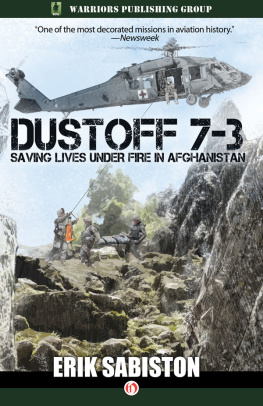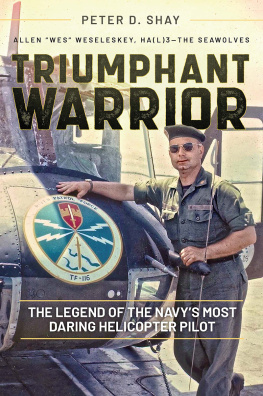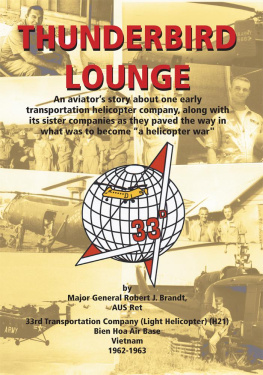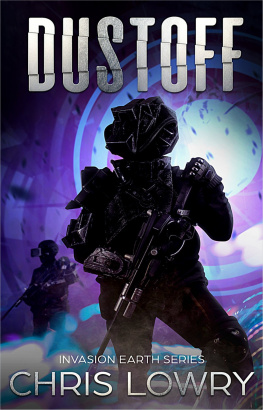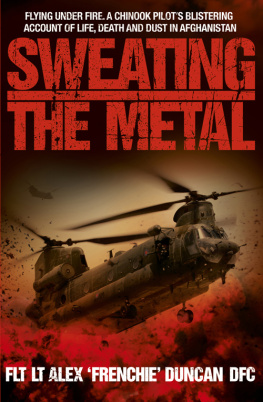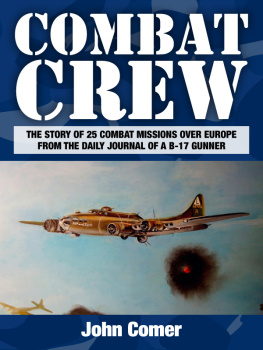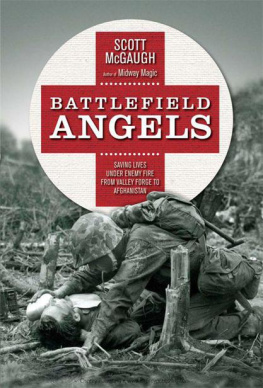what makes the story so special isnt the details of those daysthe shark-toothed terrain, thin air, and thinner marginsbut the weirdly pedestrian nature of it all. The Army air ambulance corps is the only fully equipped emergency fleet in the military, and heroism is inscribed in its basic job description. Its helicopters are on the front lines of a parallel war effort, a mission not to take lives but to save themand, almost unbelievably, its a mission thats working.
Newsweek
I expected adrenaline junkies or war cowboys, but instead found four regular people susceptible to the same fears and doubts as anyone else.
Tony Dokoupil NBC News
Absolutely incredible.
Charlie RoseCBS News
Dustoff 7-3
Saving Lives Under Fire in Afghanistan
Erik Sabiston

WARRIORS PUBLISHING GROUP
NORTH HILLS, CALIFORNIA
All rights reserved, including without limitation the right to reproduce this ebook or any portion thereof in any form or by any means, whether electronic or mechanical, now known or hereinafter invented, without the express written permission of the publisher.
The views presented are those of the author and do not necessarily represent the views of the Department of Defense (DOD), its components, or its personnel.
Copyright 2015 by Dale A. Dye
Cover art copyright 2015 by Gerry Kissell (gerrykissell.com)
978-1-5040-1350-5
Warriors Publishing Group
16129 Tupper Street
North Hills, California 91343
www.warriorspublishing.com

Distributed by Open Road Integrated Media, Inc.
345 Hudson Street
New York, NY 10014
www.openroadmedia.com

For Tess
In memory of:
SFC Jared Monti
SSG Patrick Lybert
SPC Brian Bradbury
SSG Heathe Craig
1LT Dimitri del Castillo
SGT Nigel Kelly
SPC Kevin Hilaman
CPL Angelo Vaccaro
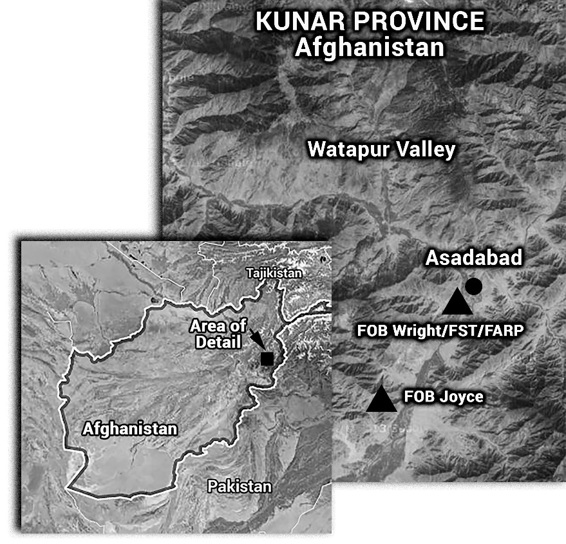
Prologue
I am not a hero. I believe what a Green Beret once told me: all the heroes he knew were buried at Arlington. The last time I met a Green Beret, he was riding in the back of our medevac helicopter, his right eye having been blown out that morning. He sat on the floor with a huge, bloody bandage wrapped over his head and under his scraggly beard. He refused all pain medicine. He was laughing and joking. Whatever place we had picked him up from seconds earlier was a place so terrible to him that getting out of there aliveeven after losing an eyemade that day the best day of his life.
I get paid to pick people up on the worst day of their lives. The day they scream for their Mom, the day they thrash against agonizing pain and face eternity alone, thousands of miles from the very people that they got out of bed for that morning. Just before we flew them out, every one of them imagined that theyd live to see their grandkids grow up. I have to fly as fast as I can, but I cant fly fast enough. I can still see their faces, clenched in agony and desperation, and then the shock as their eyes widen and their skin pales to a sickening fish-belly white. They see through me. I am the chariot driver that takes them to their death.
I know what that Green Beret meant about heroes buried at Arlington. So when I look at the November 12th edition of Newsweek magazine, I see a fraud depicted in the featured article. A banner headline on the cover declares its The Heroes Issue and those words run right across my chest. In the cover photo, two members of my helicopter crew stand on either side of me in our flight gear as we stare into space. The photographer kept asking us to think about the mission while we stood there uncomfortably for what seemed like forever. All I could think about was that Sergeant Julia Anne Bringloe should have been there with us. Without my flight medic, it was an empty moment. If anything, she should have been on the cover by herself. And I should not have been there at all. Im no herobut I do fly heroes to a hospital. Or on the first leg of their journey to the grave.
Not everybody who fights in combat is a hero.
Not every hero in a war fights.
This story is for heroes.
Chapter 1: ALONE
Not for fame or reward, nor lured by ambition or goaded by necessity, but in simple obedience to duty.
Inscription on a headstone at Arlington National Cemetery
The Kunar Valley, Afghanistan
21 June 2006
Thats my guy. Im gonna get him, Staff Sergeant Jared Monti shouted to the sniper hunkered down at his shoulder. His eyes were fixed on his wounded comrade. He tossed his radio at the man and started to move. Youre Chaos 3-5 now!
Monti surveyed the situation on the battlefield with a growing sense of horror. More than 50 Taliban fighters had ambushed his team. The Taliban knew where theyd be, tipped off by watching yesterdays resupply mission. And now one man was dead and others seriously wounded. The most pressing problem was Private First Class Brian Bradbury, hit by shrapnel from a rocket-propelled grenade and lying motionless on his stomach in the open, just a few meters from where Monti crouched behind cover. Bradbury was close, but the Taliban was shooting at anything that moved on this bad day in the mountains of eastern Afghanistan, so reaching him was going to be difficult and dangerous. Bradbury was badly hurt and terrified, but he couldnt move. It was almost suicide for anyone to try and reach him. Staff Sergeant Monti knew thatand he also knew he had to try.
As his soldiers laid down a barrage of covering fire, Monti dove into the open and headed for the wounded man. He was driven back to cover twice with bullets tearing up the ground and whistling past his head. On his third try to reach his friend, Monti made better progress, dodging and ducking through scrabble and battlefield debris. He nearly made it, but the Taliban saw what was happening and directed a barrage of RPGs and small arms at both men out there in the open. There was a scream of pain and then all the other survivors of the ambush realized they had another casualty.
As Monti lay bleeding next to Bradbury, the air support hed called for finally arrived overhead. Two attack jets dove on the Taliban positions, dropping bombs that landed just a few hundred yards from the battered infantry unit. Shrapnel obliterated treetops and smoking slivers of blasted wood fell all around the grunts that huddled in place, hoping the bombs would either kill the Taliban or drive them out of the area. The ordnance was falling so close that the detonations nearly deafened them and threatened to loosen teeth. Those that were brave enough to take a quick peek saw waves of fire consuming the hillside where the Taliban had dug in to spring their ambush.
And then it was over. The jets disappeared, and so did the Taliban. Darkness began to descend on the Kunar Valley. The soldiers broke cover to deal with their wounded and dead. The only chance for the wounded now was a Medevac helicopter. Dustoff would come. They always did.
At Jalalabad Air Base, most of the 159th Air Ambulance Company was asleep, sweating fitfully in the makeshift collection of plywood rectangles that served as their headquarters inside. In the aircraft hangars where the units Blackhawk helicopters were parked, the hangar floor was awash in light. Mechanics and technicians shuffled around the birds that were undergoing routine maintenance. The over-stressed and weary ground crews lumbered around the UH-60A model Blackhawks, replacing components damaged by the furious flying and harsh elements that ground mercilessly at engines, airframes, and electronics. On these helicopters, dedicated to medical evacuation duties, all weapons had been permanently removed. Their defenses were hotrod pilots and five red crosses painted on the birds to mark them as air ambulances. That was supposed to keep the Taliban from shooting at them, but most of the medevac aircrews thought the bright red crosses just gave the enemy a better aiming point.
Next page
